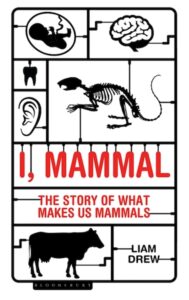Mammal – noun (mam·mal | \ ˈma-məl \)
Definition: any of a class (Mammalia) of warm-blooded higher vertebrates (such as placentals, marsupials, or monotremes) that nourish their young with milk secreted by mammary glands, have the skin usually more or less covered with hair, and include humans. (source: Merriam Webster)
As a definition, it’s a start – in fact it’s perhaps as much as one is likely to receive in answer to the question “What is a mammal?” posed to any random person passing on the street (assuming they answer at all rather than taking the more logical responsive action of simply calling the authorities). However it leaves out quite a lot by failing to include even a single word about middle ear bones, the hypothalamus, teeth, homeothermy, or scrota.
In his fascinating book I, Mammal; the Story of What Makes Us Mammals, Dr. Liam Drew writes quite extensively about middle ear bones, the hypothalamus, teeth, homeothermy, and scrota – particularly scrota. In fact, it was the interaction of a fast-moving football with his own that moved him to write the book in the first place (after he himself regained the ability to move and think coherently following the football’s impact, of course).
Fortunately for he and his wife, no permanent damage was done – as was proven by the subsequent birth of their two daughters, the eldest of whom figures very prominently in his narrative. He draws upon the experiences of both the pain on the football pitch and the tsunami of emotions and experiences in the maternity ward to weave the many inter-related inquiries into both the evolutionary development and modern life histories of mammals. True to the tradition of books published under Bloomsbury’s Sigma Science imprint, the purpose of which is to celebrate “great popular science writing across a huge range of subjects” (recall Dr. Helen Scales’ superb The Eye of the Shoal and Spirals in Time, or Dr. Louisa Preston’s Goldilocks and the Waterbears), Dr. Drew’s I, Mammal is filled with that delightful mixture of personal anecdotes, wry witticisms, and serious scientific explanations that distinguish the very best in popular science writing.
Reading I, Mammal, I was repeatedly stopped in my progress to jot down pages of notes so as not to forget information, ideas, and visual representations of concepts either wholly new to me or, of which I was aware but not possessed of a sufficient understanding thereof. I found myself often, finger marking the page, drifting into mental field trips initiated by a comment – sometimes profound, other times clever, often both – the implications of which simply necessitated immediate cogitation. And, perhaps most significantly to me as the defining quality of a truly worthwhile book, I found it difficult to resist the urge to share with others what I had recently read – which, given the often “bits” related nature of the topic at hand, was perhaps not always the most welcomed by others or socially appropriate thing to do (see my cheese-and-lactation related posts on the Twitter account of The Well-read Naturalist for a perfect example of this).
I found myself particularly fascinated by Dr. Drew’s remarkably engaging explanations of the division of the therian (collectively the marsupial and placental mammals) from the monotreme (i.e., platypus, echidna) mammals, the remarkable evolution of the monotremes themselves, the division of all of these from the cynodonts, these from the therapsids, and these from the pelycosaurs. If some of these names are not familiar, they very much will be after reading this book – and with this newly acquired familiarity, multi-faceted and endlessly intriguing “what if” questions will present themselves.
Indeed, the very name “mammal” itself will cease to be the mundane word it has too often become from false over-familiarity (which most certainly breeds at least indifference if not exactly contempt) and begin to signify the wondrously complex, sometimes perplexing, assembly of evolved physical structures and behavioral traits that imperfectly define the class Mammalia, to which everyone reading this essay belongs.
I not only highly recommend reading I, Mammal, I also recommend doing so – as I did – with a notebook and pencil ready at hand so as to be ready to record the many interesting points, intriguing connections, clever (sometimes also delightfully droll) similes, and other items of interest Dr. Drew has included in his narrative. It is a book that not only brings new information to light, it helps to make connections between facts that might have already been known by the reader but not yet placed in a relationship to one another. For all this, for the immensity of new knowledge, improved understanding, entertaining stories, and perhaps most of all thought-provoking personal reflections, Dr. Drew has my most hearty gratitude for the writing of this book, and I have full faith that those who take my recommendation to read it to heart will find themselves offering up their own thanks to him as well.
 Title: I, Mammal; the Story of What Makes Us Mammals
Title: I, Mammal; the Story of What Makes Us Mammals
Author: Liam Drew, PhD.
Publisher: Bloomsbury
Imprint: Bloomsbury Sigma
Format: Paperback
Pages: 352 pp., w/ 14 b&w Illus.
ISBN: 9781472922915
Published: May 2019
In accordance with Federal Trade Commission 16 CFR Part 255, it is disclosed that the copy of the book read in order to produce this review was provided gratis to the reviewer by the publisher.
